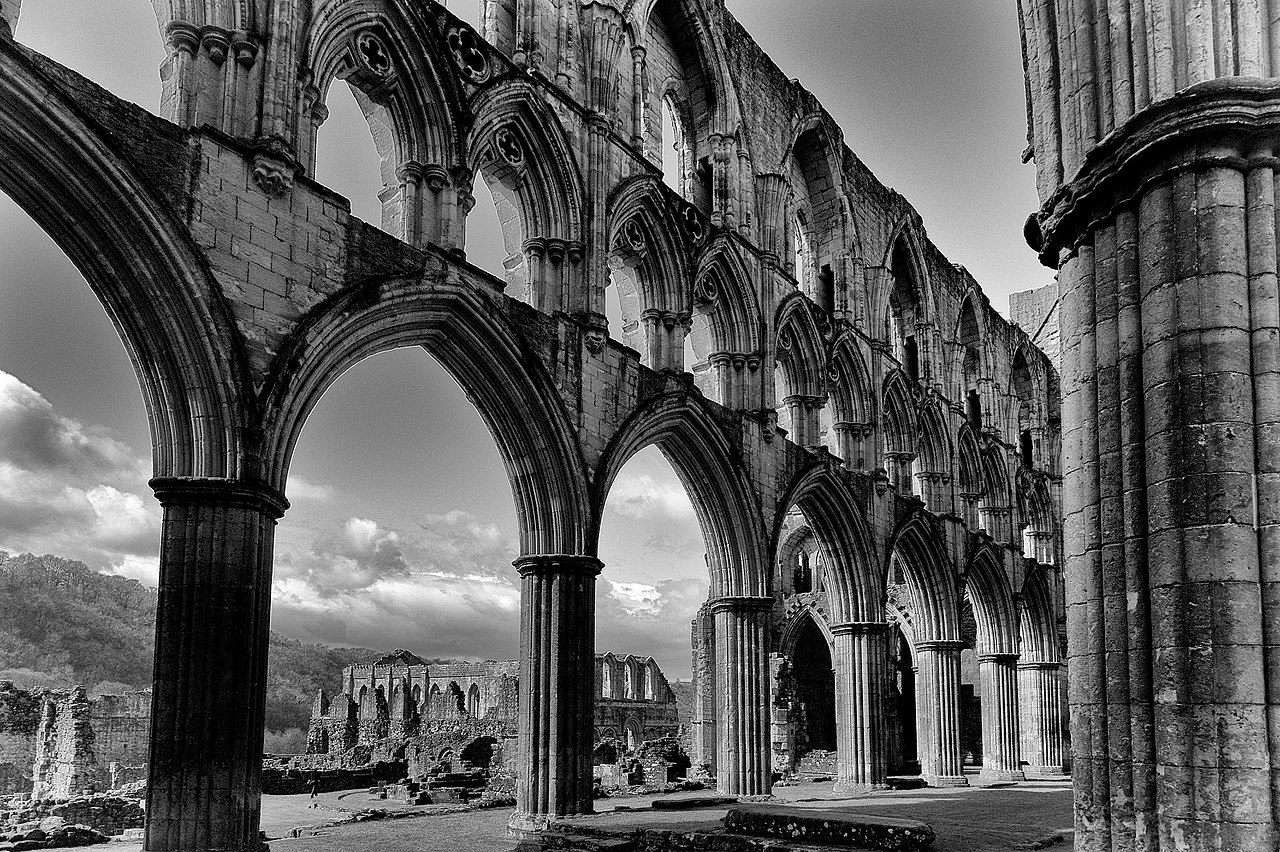Text and Illustrations from Wikipedia - the free encyclopaedia,
unless otherwise stated.
Strasbourg Cathedral,
Alsace, France.
Photo: 8 February 2014.
Source: Own work.
"Photo by DAVID ILIFF.
License: CC-BY-SA 3.0"
(Wikimedia Commons)
The Nave,
Strasbourg Cathedral,
Alsace, France.
Photo: 8 February 2014.
Source: Own work.
"Photo by DAVID ILIFF.
License: CC-BY-SA 3.0"
(Wikimedia Commons)
Strasbourg Cathedral, or the Cathedral of Our Lady of Strasbourg (
French:
Cathédrale Notre-Dame de Strasbourg,
German:
Liebfrauenmünster zu Straßburg), also known as Strasbourg
Minster, is a
Roman Catholic Cathedral in
Strasbourg,
Alsace,
France.
Although considerable parts of it are still
Romanesque architecture, it is widely considered to be among the finest examples of High-, or Late-,
Gothic architecture.
Erwin von Steinbach is credited for major contributions from 1277 to his death in 1318.
At 142 metres (466 feet) high, it was the
World's tallest building from 1647 to 1874 (227 years), when it was surpassed by
Saint. Nikolai's Church, Hamburg, Germany. Today, it is the sixth-
tallest Church in the World and the highest still-standing structure built entirely in The
Middle Ages.
English: Statues on the Right of The Great West Door, Strasbourg Cathedral.
Français: Statues de l'ébrasement droit de la porte centrale du portail occidental
de la cathédrale de Strasbourg.
Photo: 27 December 2008.
Source: Own work.
(Wikimedia Commons)
Described by
Victor Hugo as a "gigantic and delicate marvel", and by
Goethe as a "sublimely towering, wide-spreading Tree of God", the Cathedral is visible far across the Plains of
Alsace and can be seen from as far off as The
Vosges Mountains or The
Black Forest on the other side of The
Rhine.
Sandstone, from The
Vosges, used in construction, gives the Cathedral its characteristic pink hue.
The site of Strasbourg Cathedral was used for several successive Religious buildings, starting from the
Argentoratum period (when a Roman
Sanctuary occupied the site) up to the building that is there today.
It is known that a Cathedral was erected by Bishop Saint Arbogast, of the
Strasbourg Diocese, at the end of the 7th-Century A.D., on the base of a
temple Dedicated to The
Virgin Mary, but nothing remains of it today. Strasbourg's previous Cathedral, remains of which, dating back to the Late-4th-Century or Early-5th-Century, were unearthed in 1948 and 1956, was situated at the site of the current
Église Saint-Étienne.
English: West façade of the Cathedral Notre-Dame de Strasbourg.
Français: Façade ouest de la cathédrale Notre-Dame de Strasbourg.
Photo: 20 August 2005.
Source: Own work.
(Wikimedia Commons)
In the 8th-Century A.D., the first Cathedral was replaced by a more important building that would be completed under the Reign of
Charlemagne. Bishop Remigius von Straßburg (also known as Rémi) wished to be buried in the Crypt, according to his
Will, dated 778 A.D. It was certainly in this building that the
Oaths of Strasbourg were pronounced in 842 A.D. Excavations carried out, recently, reveal that this
Carolingian Cathedral had three
Naves and three
Apses. A poem described this Cathedral decorated with Gold and Precious Stones by Bishop Ratho (also Ratald or Rathold). The Basilica caught fire on multiple occasions, in 873 A.D., 1002, and 1007.
English: Chandelier and Stained-Glass Windows,
Our Lady of Strasbourg Cathedral,
Strasbourg, France.
Français: Chandelier du collatéral sud,
Notre Dame, Strasbourg, France.
Photo: 8 March 2011.
Source: notre dame (7)
(Wikimedia Commons)
In 1015, Bishop
Werner von Habsburg laid the first Stone of a new Cathedral on the ruins of the
Carolingian Basilica. He then constructed a Cathedral in The
Romanesque Style of architecture. That Cathedral burned to the ground in 1176, because, at that time, the Naves were covered with a wooden framework.
After that disaster, Bishop Heinrich von Hasenburg decided to construct a new Cathedral, to be more beautiful than that of
Basel, which was just being
finished. Construction of the new Cathedral began on the Foundations of the preceding structure, and did not end until Centuries later. Werner's Cathedral's
Crypt, which had not burned, was kept, and expanded Westwards.
of Strasbourg Cathedral.
Photo: September 2007.
Source: Own work.
(Wikimedia Commons)
The construction began with the
Quire (Choir) and the North
Transept in a Romanesque Style, reminiscent of, and actually inspired by, the
Imperial Cathedrals in its monumental size and height. But, in 1225, a team coming from
Chartres revolutionised the construction by suggesting a
Gothic Style.
The parts of the Nave that had already been begun, in Romanesque Style, were torn down and, in order to find money to finish the Nave, the
Chapter resorted to
Indulgences in 1253. The money was kept by the
Œuvre Notre-Dame (Editor: The Strasbourg Museum), which also hired architects and Stone-Workers. The influence of the Chartres Masters was also felt in the sculptures and statues; the "Pillar of Angels" (
Pilier des anges), a representation of The
Last Judgment on a
Pillar in the Southern
Transept, facing the Astronomical Clock, owes to their expressive style.
Like the City of Strasbourg, the Cathedral connects
German and
French cultural influences, while the Eastern structures, e.g. The Choir and South Portal, still have very
Romanesque features, with more emphasis placed on walls than on windows.
English: "The Marriage Feast at Cana" Tapestry in the Nave of Strasbourg Cathedral.
Français: Tapisserie "Les noces de Cana" dans la nef de la cathédrale de Strasbourg.
Photo: 5 December 2009.
Source: Own work.
(Wikimedia Commons)
Above all, the famous West Front, decorated with thousands of figures, is a masterpiece of the
Gothic era. The Tower is one of the first to rely substantially on craftsmanship, with the final appearance being one with a high degree of linearity captured in stone. While previous façades were certainly drawn prior to construction, Strasbourg has one of the earliest façades whose construction is inconceivable without prior drawing.
Strasbourg Cathedral and
Cologne Cathedral together represent some of the earliest uses of architectural drawing. The work of Professor Robert O. Bork, of the
University of Iowa, suggests that the design of the Strasbourg façade, while seeming almost random in its complexity, can be constructed using a series of rotated octagons.
The North Tower, completed in 1439, was the world's tallest building from 1647 (when the Spire of
Saint Mary's Church, Stralsund, Germany, burnt down) until 1874, (when the Tower of
Saint Nikolai's Church in Hamburg, Germany, was completed). The planned South Tower was never built and, as a result, with its characteristic asymmetrical form, Strasbourg Cathedral is now the premier landmark of
Alsace. One can see thirty kilometers from the Observation Level, which provides a view of the
Rhine Banks, from the
Vosges all the way to The
Black Forest. The
Octagonal Tower is the combined work of architects
Ulrich Ensingen (Shaft) and
Johannes Hültz of
Cologne (top). Ensingen worked on the Cathedral from 1399 to 1419, and Hültz from 1419 to 1439.
Strasbourg Cathedral's
Astronomical Clock.
Photo: 8 February 2014.
Source: Own work.
"Photo by DAVID ILIFF.
License: CC-BY-SA 3.0"
(Wikimedia Commons)
In 1505, architect Jakob von Landshut and sculptor Hans von Aachen finished re-building the Saint-Lawrence
Portal (Portail Saint-Laurent), outside the Northern Transept, in a markedly Post-Gothic, Early-
Renaissance Style. As with the other Portals of the Cathedral, most of the statues now to be seen in situ are copies, the originals having been moved to the
Musée de l’Œuvre Notre-Dame.In the Late Middle Ages, the City of Strasbourg had managed to liberate itself from the domination of the
Bishop and to rise to the status of
Free Imperial City. The outgoing 15th-Century was marked by the Sermons of
Johann Geiler von Kaisersberg and by the emerging
Protestant Reformation, represented in Strasbourg by figures such as
John Calvin,
Martin Bucer and
Jacob Sturm von Sturmeck.
In 1524, the City Council assigned the Cathedral to the
Protestant faith, while the building suffered some damage from
iconoclastic assaults. In 1539, the world's first documented
Christmas Tree was set up inside the Münster. After the annexation of the City by
Louis XIV of France, on 30 September 1681, and a Mass celebrated in the Cathedral on 23 October 1681 in the presence of the King and Prince-Bishop,
Franz Egon of Fürstenberg, the Cathedral was returned to the Catholics and its inside re-designed according to The Catholic Liturgy of The
Counter-Reformation.
This File: 23 January 2006.
(Wikimedia Commons)
In 1682, the
Choir Screen (built in 1252) was broken out to expand the
Quire (Choir) towards the Nave. Remains of The Choir Screen are displayed in the
Musée de l’Œuvre Notre-Dame and in
The Cloisters. The
Main, or High, Altar, a major work of Early-
Renaissance sculpture, was also demolished that year. Fragments can be seen in the
Musée de l’Œuvre Notre-Dame.A round, Baroque
Sacristy, of modest proportions, was added North-East of the Northern Transept, in 1744, by the City's Chief Architect,
Joseph Massol, according to Plans by
Robert de Cotte. Between 1772 and 1778, architect Jean-Laurent Goetz surrounded the Cathedral with a Gallery, in Early-
Gothic-Revival Syle, in order to re-organise the merchants' shops that used to settle around the building (and would do so until 1843).
In April 1794, the
Enragés, who ruled the City, started planning to tear the Spire down, on the grounds that it hurt the principle of equality. The
Tower was saved, however, when, in May of the same year, citizens of Strasbourg crowned it with a giant tin
Phrygian Cap, of the kind the Enragés themselves wore. This artifact was later kept in the historical collections of the City, until they were all destroyed in a massive fire in August 1870.
Engraving depicting the inside of
Published by Isaak Brun.
Source: http://www.metmuseum.org/Collections/search-the-collections/
90023273?rpp=60&pg=1&gallerynos=690&ft=*&pos=57
(Wikimedia Commons)
During
World War II, Strasbourg's Cathedral was seen as a symbol for both warring parties.
Adolf Hitler, who visited it on 28 June 1940, intended to transform the Church into a "National Sanctuary of the German People" or into a
Monument to The Unknown Soldier, on 1 March 1941,
General Leclerc, of France, made the "Vow of
Kufra" (
Serment de Koufra), stating he would "rest the weapons only when our beautiful Colours fly again on Strasbourg's Cathedral". During that same war, the Stained-Glass was removed, in seventy-four Cases, from the Cathedral and stored in a Salt Mine, near
Heilbronn, Germany. After the war, it was returned to the Cathedral by the Monuments, Fine Arts and Archives Section of the United States Military.
English: The Tempter courting The Foolish Virgins
(sculpture in the South Aisle Portal of the West Façade).
Français: Strasbourg, portail sud de la cathédrale. Le tentateur (il tient la pomme
de la tentation, son dos est dévoré par des crapauds et des reptiles) et les vierges
folles (elles tiennent les lampes retournées, serrent fermées les tables de la loi).
Photo: 12 November 2010.
Source: Own work.
(Wikimedia Commons)
The Cathedral was hit by British and American bombs during air raids on Strasbourg's Centre, on 11 August 1944, which also heavily damaged the
Palais Rohan and the
Sainte-Madeleine Church. In 1956, the
Council of Europe donated the famous Choir Window, by Max Ingrand, the "Strasbourg Madonna" (see also
Flag of Europe Biblical interpretation). The last War Damages were only repaired in the Early-1990s.
In October 1988, when the City was commemorating 2,000 years of the Founding of
Argentoratum, Pope Saint John Paul II visited and Celebrated Mass in the Cathedral. This event was also an occasion to celebrate the Franco-Germany Reconciliation.
In 2000, an
Al-Qaeda plot to bomb the adjacent Christmas Market was prevented by French and German Police.
Photo: 20 December 2010.
Source: Own work.
Attribution: “DerHexer, Wikimedia Commons, CC-by-sa 4.0”.
(Wikimedia Commons)
Strasbourg Cathedral's Rose Window
and the Organ.
Photo: 22 December 2011.
Source: Cathédrale Notre-Dame.
(Wikimedia Commons)


-35.jpg)

























